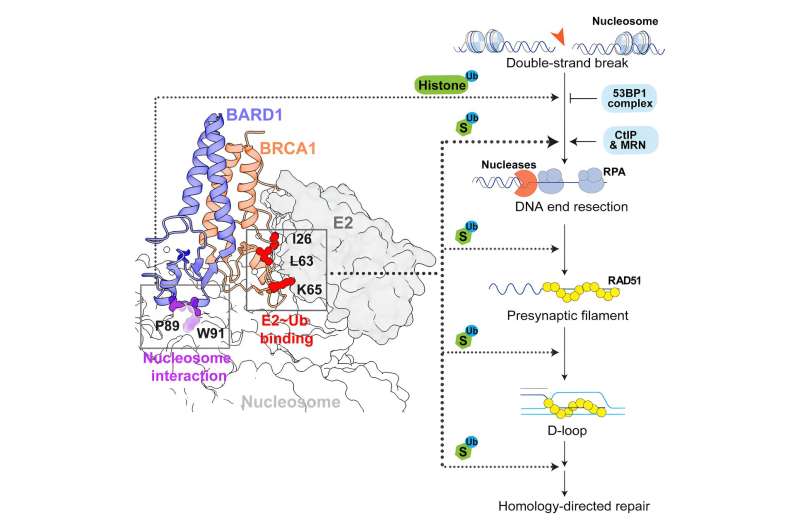This article has been reviewed according to Science X's editorial process and policies. Editors have highlighted the following attributes while ensuring the content's credibility:
fact-checked
peer-reviewed publication
trusted source
proofread
New research reveals how mutations in BRCA1 affect cancer susceptibility in women

Three decades after discoveries linking mutations in the BRCA1 gene to breast and ovarian cancer susceptibility, research led by Mays Cancer Center at The University of Texas Health Science Center at San Antonio (UT Health San Antonio) has pinpointed the molecular mechanism by which a large portion of these mutations cause cancers in women.
The discovery, unveiled in a research article in the journal Molecular Cell, is poised to assist researchers in developing drugs to battle breast and ovarian cancers and to help identify women who are at an elevated risk of developing these cancers, according to the authors.
The article is titled, "Crucial Roles of the BRCA1-BARD1 E3 Ubiquitin Ligase Activity in Homology-Directed DNA Repair," with lead author Weixing Zhao, Ph.D., assistant professor of biochemistry and structural biology, the Greehey Children's Cancer Research Institute (GCCRI) and Mays Cancer Center at UT Health San Antonio.
Other corresponding authors include Sandeep Burma, Ph.D., professor and vice chair (research) of neurosurgery at UT Health San Antonio and Mays Cancer Center, and Rachel E. Klevit, Ph.D., professor of biochemistry at the University of Washington. Additional researchers are from GCCRI and the departments of biochemistry and structural biology, neurosurgery, obstetrics and gynecology, and molecular medicine at UT Health San Antonio; University of Washington; Dartmouth College; Colorado State University; and The University of Texas Southwestern Medical Center.
While it's established that BRCA1 (Breast Cancer Gene 1) in conjunction with an essential partner gene BARD1 (BRCA1 Associated Ring Domain 1) act as a safeguard against cancer, how exactly it accomplishes this has been a matter of debate. One vital function of BRCA1, known as E3 ligase activity that was first reported in 1999, has been particularly spotlighted.
This activity allows BRCA1 to regulate key proteins involved in DNA repair and other biological processes by tagging these proteins with "ubiquitin moieties," which refer to tiny molecular tags that can be attached to proteins inside our living cells. These tags are like little flags that signal different actions for those proteins.
However, in 2011, researchers using a specially designed variant of the BRCA1 gene (I26A), which was thought to lack the E3 ligase activity, concluded that this activity wasn't necessary for BRCA1's ability to prevent cancer. This conclusion remained at odds with the fact that a large number of BRCA1 mutations seen in patients actually fall within the E3 ligase domain of BRCA1.
"That work and many subsequent studies using the same mutant have shaped the field and its research for more than a decade, with more than 200 papers published using the BRCA1-I26A mutant," Zhao said. "However, critical validation showing that the mutant is indeed 'ligase-dead' in a physiological context has never been reported."
So, the team set about generating highly purified full-length BRCA1-BARD1 and several of its known cellular substrates that allowed them to establish robust BRCA1-BARD1-mediated in vitro ubiquitylation reactions. "This essentially not only allowed us to finally put underlying assumptions that had gone unquestioned for decades to the test," Zhao said, "but we also sifted through a bunch of mutations to find the one that really shuts down the E3 ligase activity."
Using this approach, the researchers found that the mutant that was used in previous studies and believed to lack E3 ligase activity actually retains a strong level of this activity, challenging the longstanding belief that this activity of BRCA1 is not required for suppressing tumor formation. Furthermore, by finding a truly inactive mutant, they re-examined whether and how this activity is involved in DNA repair and tumor suppression.
"With this specific non-working mutant, our experiments clearly demonstrated that this enzyme is crucial in several stages of DNA repair," Zhao said. "Additionally, we found that the process of BRCA1-BARD1 adding ubiquitin to histones plays an important role in repairing DNA breaks, further strengthening our conclusion about this E3 ligase activity of BRCA1."
Burma added, "Our findings necessitate reinterpretation of scores of previous studies involving the BRCA1-I26A mutant and provide us with a fresh perspective on the tumor-suppressor roles of BRCA1."
More information: Meiling Wang et al, Crucial roles of the BRCA1-BARD1 E3 ubiquitin ligase activity in homology-directed DNA repair, Molecular Cell (2023). DOI: 10.1016/j.molcel.2023.09.015



















